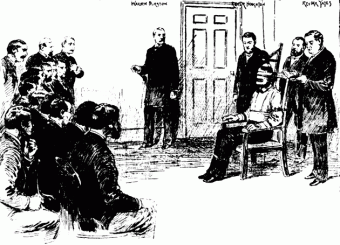This Day in History: August 6th
This Day In History: August 6, 1890
 “I would rather see ten hangings than one such execution as this. In fact I never care to witness such a scene again. It was fearful. No humane man could witness it without the keenest agony.” – Deputy Coroner Jenkins of New York
“I would rather see ten hangings than one such execution as this. In fact I never care to witness such a scene again. It was fearful. No humane man could witness it without the keenest agony.” – Deputy Coroner Jenkins of New York
On August 6, 1890, murderer William Kemmler became the first person to die in the electric chair in what went down as one of the most grisly and inhuman executions in American history.
The fact that Kemmler’s demise was so ghastly is ironic considering the electric chair was introduced in an effort to make the death penalty less distasteful because, after a series of botched hangings in the 1880s, the general public was shying away from the practice. Death by electrocution was intended to make capital punishment more “humane.”
The notion of electrocution as a more merciful method of execution began when a dentist named Dr. Albert Southwick observed an old vagrant die “painlessly” after bumping into the terminals of an electric generator in Buffalo, New York. After experimentally zapping progressively larger animals into oblivion the idea gained traction, and ended up turning into a cat fight between the two financial leaders of the fledgling electrical industry – Thomas Edison and George Westinghouse.
When Westinghouse introduced alternating current in 1886, it seriously began to affect Edison’s direct current profit margin. Edison had launched a PR campaign to convince the public of the dangers of alternating current, so when A/C was chosen to supply the current for the electric chair, no-one was happier than Thomas Edison.
Caught in the center of all this was an alcoholic vegetable peddler named William Kemmler. He killed his common-law wife Tillie Ziegler when he became convinced she was preparing to run away with one of his friends. In a fit of drunken rage, he grabbed a hatchet and brutally murdered her. He then went to a neighbor’s house and confessed he had just murdered his girlfriend. He was quickly convicted of first degree murder and was the first man sentenced to die in the electric chair at New York’s Auburn state prison.
Despite several appeals to halt the execution as cruel and usual punishment on the grounds that no-one was sure just how much electricity it would take to kill a man instantly, the decision was upheld and the execution was scheduled for August 6, 1890 at 6 a.m.
Kemmler was calm and composed as he bid farewell to the assembled witnesses. As the executioner pulled the switch, the condemned man turned beet red and convulsed. After 17 seconds the current was turned off, but Kemmler was still breathing.
People began to panic as the generator had to power up before Kemmler could be shocked again and put out of his misery. The District Attorney was so distressed he had to leave the room. After what must have seemed like eons, the current was switched on again. Blood began to appear on Kemmler’s face like beads of sweat, smoke billowed from the top of his head, and the horrible smell of burning flesh began to fill the room.
This time Kemmler was definitely dead.
It took anywhere between another minute and a half to four minutes from the time the generator powered back up for Kemmler to die. There’s no official record of the time because the events unfolding before them were so horrific that no-one took notes.
Dr. Southwick, for whatever reason, thought Kemmler’s execution was a resounding success and commented, “We live in a higher civilization from this day on.” George Westinghouse, who apparently had a firmer grip on reality, remarked, “They would have done better with an axe.”
If you liked this article, you might also enjoy our new popular podcast, The BrainFood Show (iTunes, Spotify, Google Play Music, Feed), as well as:
- Why the Man in the Famous “Saigon Execution” Photo was Killed
- There Was Once An Elephant Condemned to Execution by Hanging
- The Teenager Who was Executed Twice
- Why Proper Sterilization Procedures are Used During Lethal Injections
- The Curious Practice of Execution By Golden Shower
| Share the Knowledge! |
|




